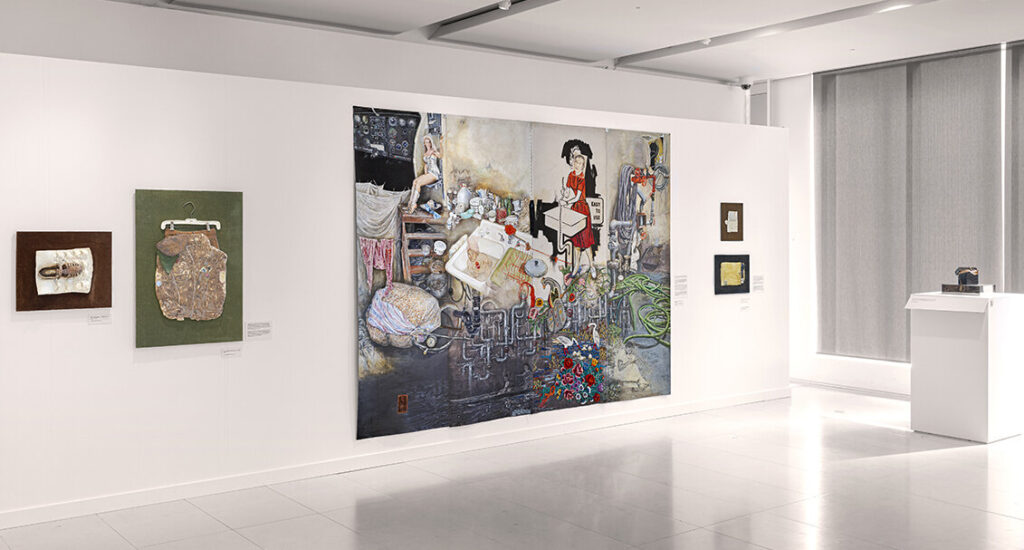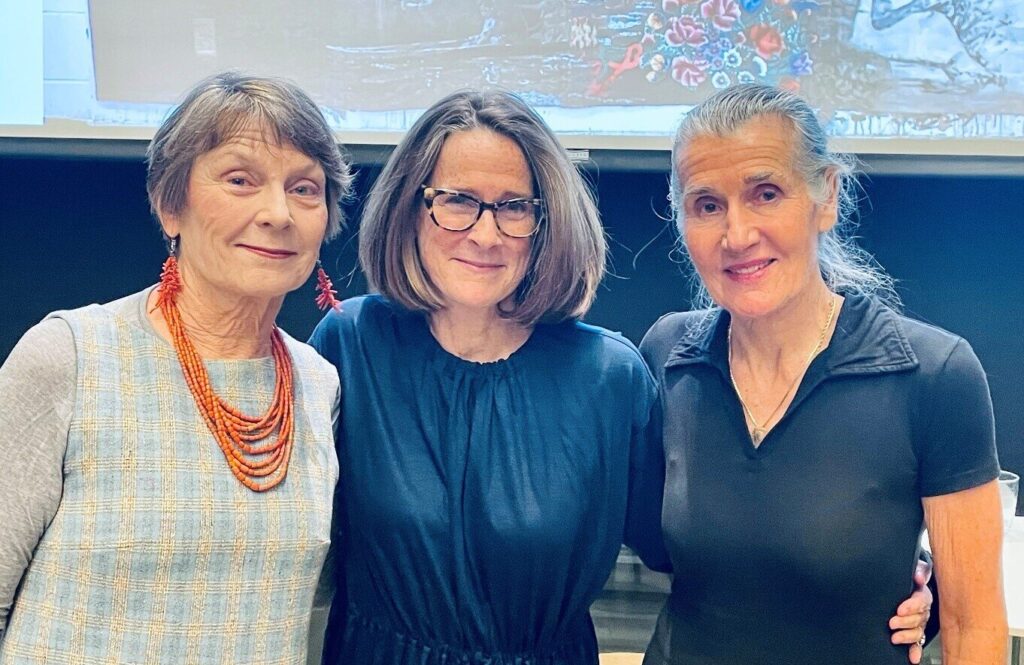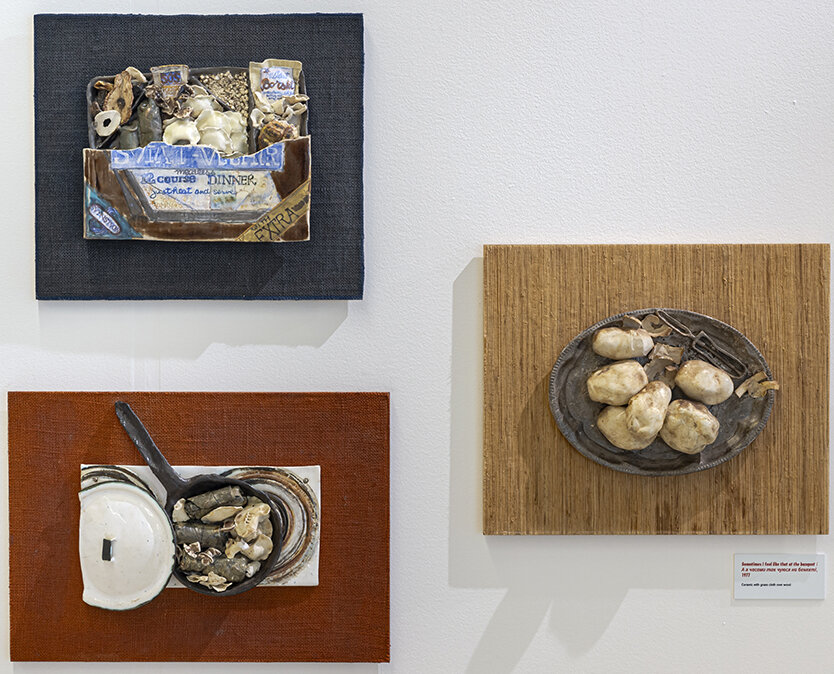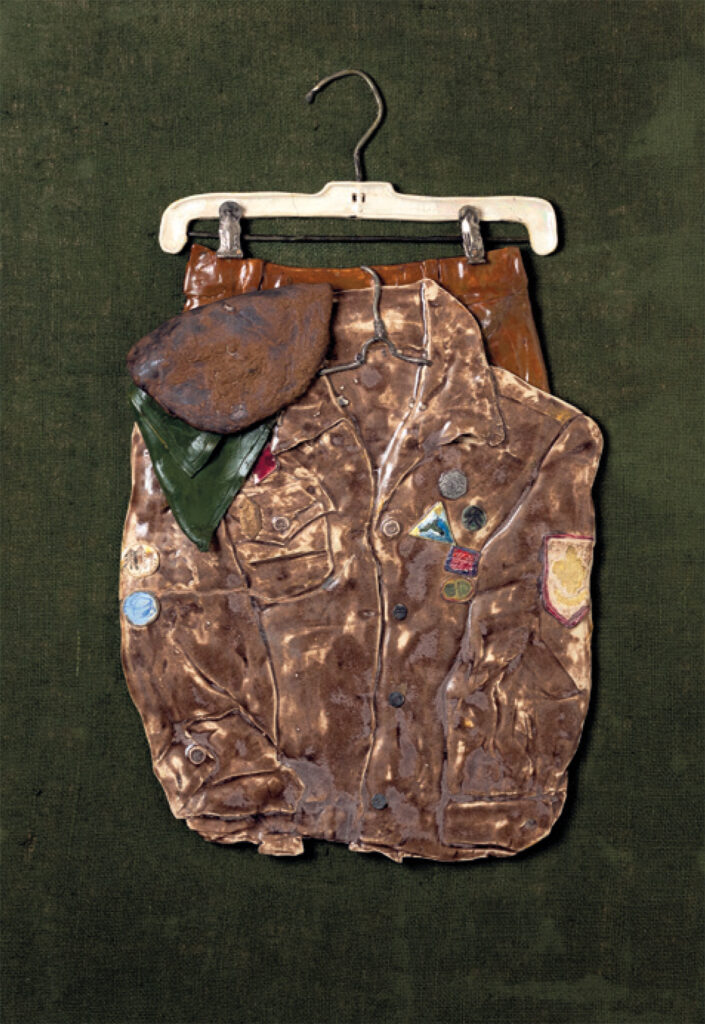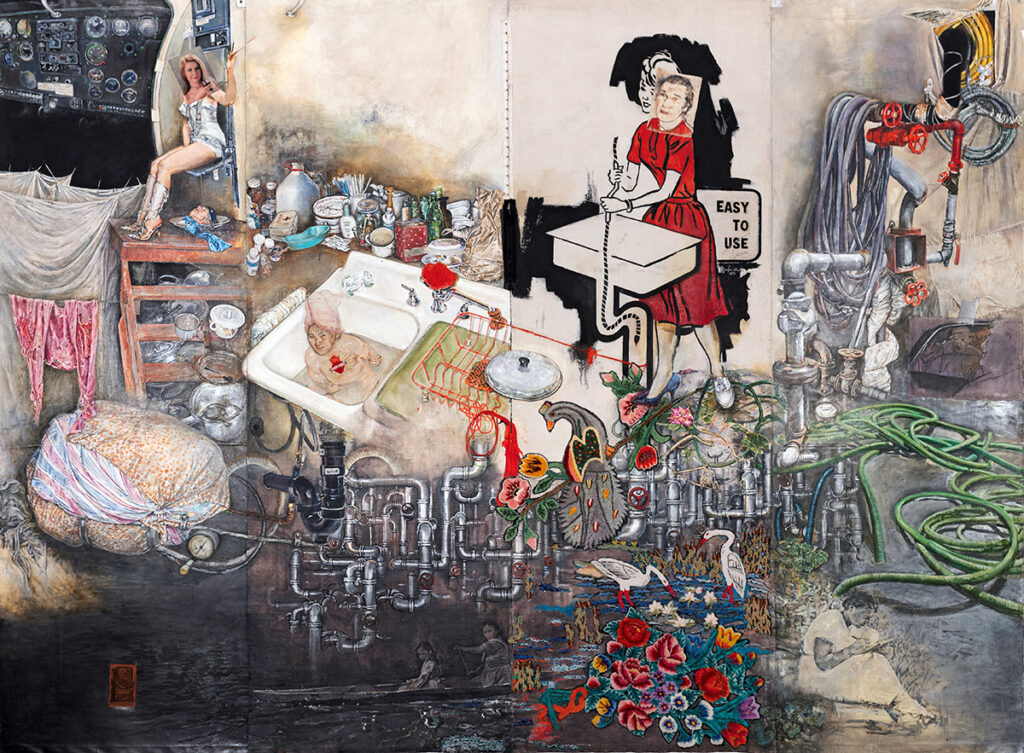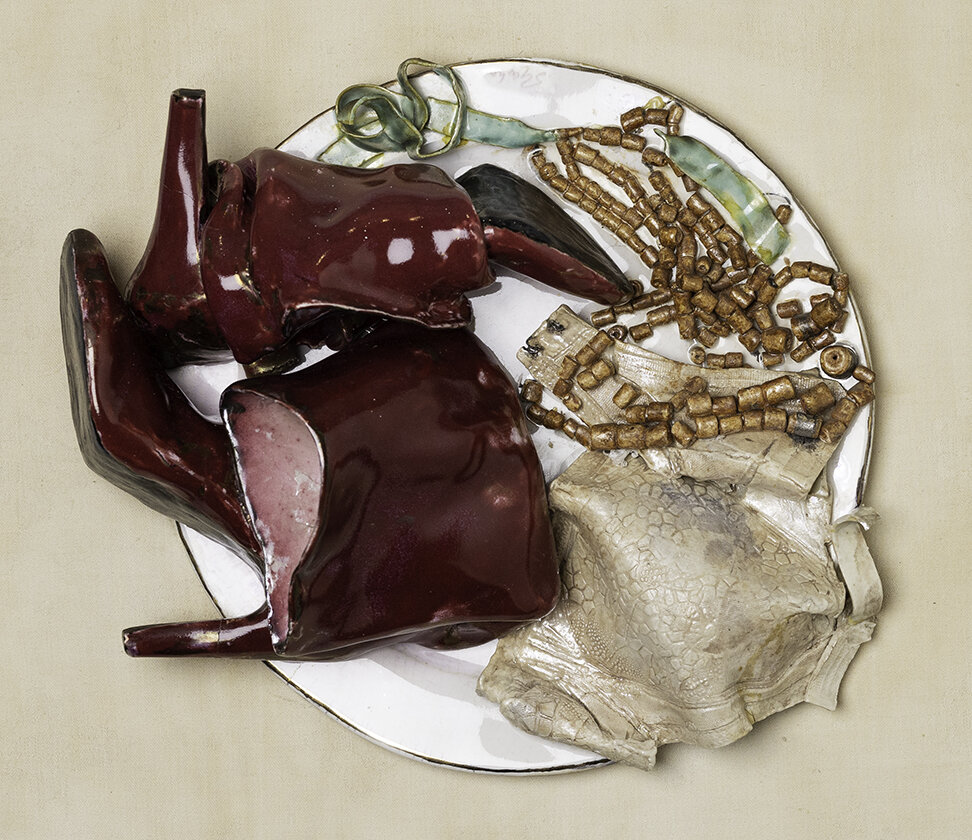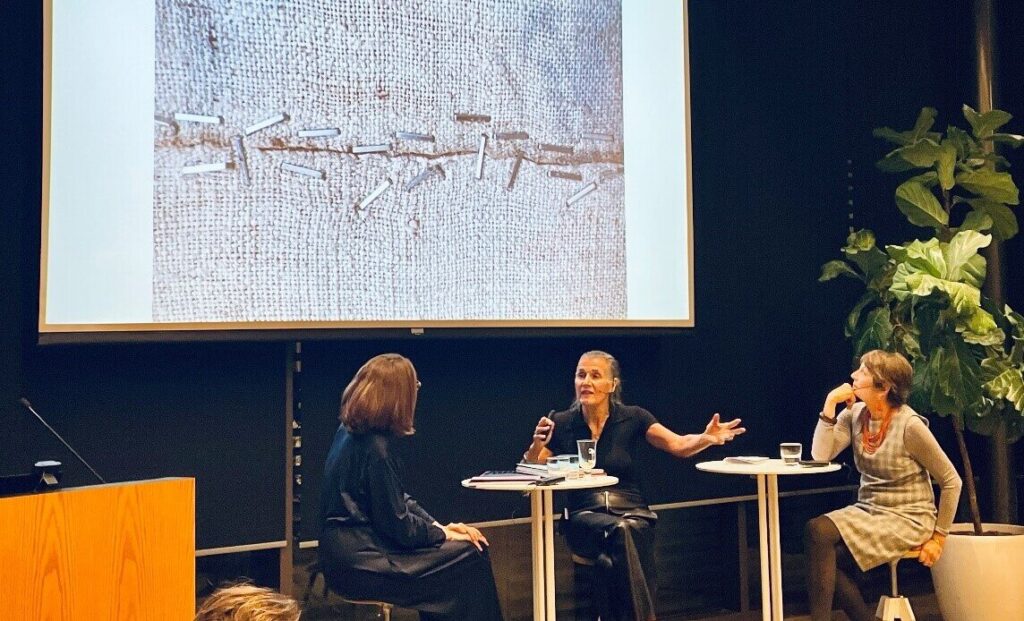Soaking Wet and On Fire is an exhibition revealing a combination of both past and present, cultural identity, femininity, diaspora, embarking us on a transformative journey from ceramic art to a single painting by Natalka Husar. For the first time in 40 years, Husar has opened her doors to the public to witness her earlier ceramic work from the late 1970s, including a large painting that took 4 years to complete. Down to every possible detail from clothing to food and letters, Husar is sharing her deep-rooted connection to her origins in Ukraine, her mother’s life stories and Husar’s experience with grief after losing her mother.
Installation view of Natalka Husar, Soaking Wet and On Fire with Losing Mama (in the middle). Courtesy of the Gardiner Museum.
In addition to this remarkable exhibition, Natalka Husar has graced us with a one-of-a-kind panel talk on November 22nd. In this program, Natalka Husar, featuring book contributors, Janice Kulyk Keefer, and Sarah Milroy, shared their stories and how they met and what inspired them to write this publication with Husar. Soaking Wet and On Fire, is a book dedicated to the exhibition Soaking Wet and On Fire: Ceramic and Painting by Natalka Husar, organized by the Gardiner Museum.
(L-R): Writers, Janice Kulyk Keefer and Sarah Milroy with artist Natalka Husar. Photo: Polyna Alekseev
Husar’s monumental painting, Losing Mama explore objects of food through pots and pans, symbolizing her diasporic experiences that emerged in the least expected ways when growing up, and how it followed her around in her earlier work. Themes of family and culture were first explored by Husar in her ceramic work which influenced her later in her career.
TV Dinner, 1977, ceramic with dyed burlap over wood, (top left), Breakfast January 7, 1977, ceramic with dyed burlap over wood (bottom left), and Sometimes I feel like that at the banquet, 1977, ceramic with grass cloth over wood (middle right). Courtesy of the Gardiner Museum.
To Husar, clay was easier to work with to achieve the results she wanted, it gave her a chance to explore the diversity in everyday subjects and objects until she got it right. During her panel talk, Husar said that even though she always knew she was an artist, she constantly found herself foreign to the media she used. When she was asked by the audience why she chose ceramics, she simply replied, “I didn’t know how to paint”. Painting was self-taught, and it was not an easy task to keep up with at some times, especially when she took a job as a flight attendant. She started to get familiar with the arts community around 1984.
Closeted Youth, 1977, ceramic with dyed burlap over wood. Courtesy of the Gardiner Museum.
Husar revealed that her mother was an exceptional seamstress which inspired Husar to explore a bigger range of materials and techniques later in her practice. She said that practicing additional skills, like sewing and tapestry helped her to connect with her mother after her passing during the pandemic emergency lockdowns. After a long period of taking care of her mother, followed by a devastating loss, Husar still found some humour in her by jokily saying “she took her last flight just in time” taking off at the age of a 100. Husar expressed that sentiment through works such as Closeted Youth where in addition to food and mail, clothing was another way of thinking of her diasporic identity, exploring the ways we find ourselves by what we wear or not. Memories and cultural identity also remain strong by practicing her mother’s craft in sewing and mending and honoring it in Losing Mama, there is an embroidered section in the centre bottom.
In Ukrainian culture, the practice of embroidery has been a long-time tradition that patched and healed generations who were taught that the art of sewing and mending is a practice of self-care and good character.
Natalka Husar, Losing Mama, 2019-2023, acrylic, lenticular post card, thread and notions on linen and canvas. Courtesy of the Gardiner Museum.
Janice Kulyk Keefer opened the panel talk on November 22nd by introducing a piece that inspired her to be a part of this project called: Sex and the Single Ukrainian Girl (1977), referring to it as “a classic example of Cinderella after midnight” when she explored the feminine culture of Eastern Europe. As a writer with a Ukrainian background herself, Keefer expressed that it was an important task for her to take, not only for her writing but as well as self-discovery of cultural identity and desire for belonging. She also shared her travels to Ukraine with Husar back in 2006, a nation in the midst of political crisis, was not only challenging but a daring task in order to successfully publish Husar’s book. The authors shared documented photos and notes which revealed exceptional teamwork in unexpected places and deep connections to craft, culture, and homeland.
Sex and the Single Ukrainian Girl, 1977, ceramic with fabric over wood. Courtesy of the Gardiner Museum.
In the exhibition, with dense mixed media work, we are witnessing the story and imagination of Natalka Husar. Viewing the painting, Losing mama, alongside her ceramics just keeps highlighting how important her early work is to her most recent piece. Just like her early practices in ceramics move towards paintings, one of them is mounted on a wall, the painting moved toward sculpture through assemblage, amplifying both her skills in sculpture and her career as a painter. In Husar’s own words – when referring to the variety of materials used to express the subject matter and concept behind her earliest work to her latest piece – “If used unexpectedly, words cannot describe the work.”
Husar is giving her audience an x-ray looks into her process work and behind the scenes of her mixed media painting Losing Mama. Photo: Polyna Alekseev
Polyna Alexseev
*Exhibition information: Natalka Husar, Soaking Wet and On Fire, September 9, 2023 – January 7, 2023, The Gardiner Museum on the 1st floor Lobby, 111 Queens Park, Toronto. Museum hours: Mon – Fri 10 am – 6 pm, Wed 10 am – 9 pm, Sat – Sun 10 am–5 pm.

